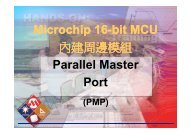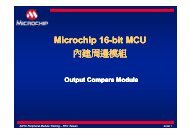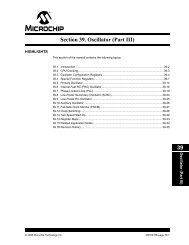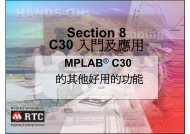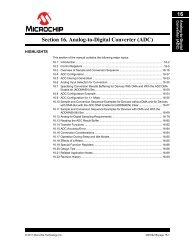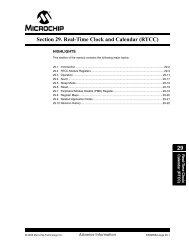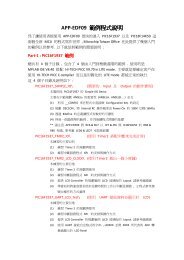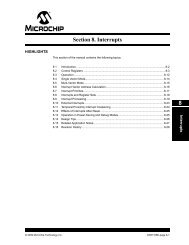Section 4. Program Memory - Microchip Taiwan
Section 4. Program Memory - Microchip Taiwan
Section 4. Program Memory - Microchip Taiwan
You also want an ePaper? Increase the reach of your titles
YUMPU automatically turns print PDFs into web optimized ePapers that Google loves.
<strong>Section</strong> <strong>4.</strong> <strong>Program</strong> <strong>Memory</strong><strong>4.</strong>5.3 PSV TimingAll instructions that use PSV require five instruction cycles to complete execution.<strong>4.</strong>5.3.1 USING PSV IN A REPEAT LOOPInstructions that use PSV with Indirect Addressing mode using a post-modification offset of +2 or-2 within a REPEAT loop eliminate some of the cycle count overhead required for the instructionaccess from program memory. These instructions have an effective execution throughput of oneinstruction cycle per iteration. However the following iterations of the REPEAT loop will executein five instruction cycles:• First iteration• Instruction execution prior to exiting the loop due to an interrupt• Instruction execution upon re-entering the loop after an interrupt is servicedThe last iteration of the REPEAT loop will execute in six instruction cycles.If the PSV Addressing mode uses an offset range other than +2 or -2 within a REPEAT loop, fiveinstruction cycles are needed to execute each iteration of the loop.Note:Unlike PSV accesses, a TBLRDx instruction requires five instruction cycles for eachiteration.<strong>4.</strong>5.3.2 PSV AND INSTRUCTION STALLSFor more information about instruction stalls using PSV, refer to <strong>Section</strong> 2. “CPU” (DS70359).<strong>4.</strong>5.4 PSV Code ExamplesExample 4-3 illustrates how to create a buffer, and access the buffer in the compiler-managedPSV section. The auto_psv space is the compiler-managed PSV section. <strong>Section</strong>s greater than32K are allowed and automatically managed. By default, the compiler places all ‘const’ qualifiedvariables into the auto_psv space.When auto_psv is used, the compiler will save/restore the DSRPAG register dynamically, asneeded. The tool chain will arrange for the DSRPAG to be correctly initialized in the compilerrun-time startup code.Example 4-3: Compiler Managed PSV Access#include _FOSCSEL(FNOSC_FRC);_FOSC(FCKSM_CSECMD & OSCIOFNC_OFF & POSCMD_NONE);_FWDT(FWDTEN_OFF);const int m[5] __attribute__((space(auto_psv))) = {1, 2, 3, 4, 5};int x[5] = {10, 20, 30, 40, 50};int sum;int vectordot (int *, int *);int main(void){// Compiler-managed PSVsum = vectordot ((int *) m, x);while(1);}int vectordot (int *m, int *x){int i, sum = 0;for (i = 0; i < 5; i ++)sum += (*m++) * (*x++);return (sum);}4<strong>Program</strong> <strong>Memory</strong>Note:The auto_psv option must be used if the user application is using both PSV andEDS accesses on a device with more than 28 KB of RAM.© 2010 <strong>Microchip</strong> Technology Inc. DS70613B-page 4-17




